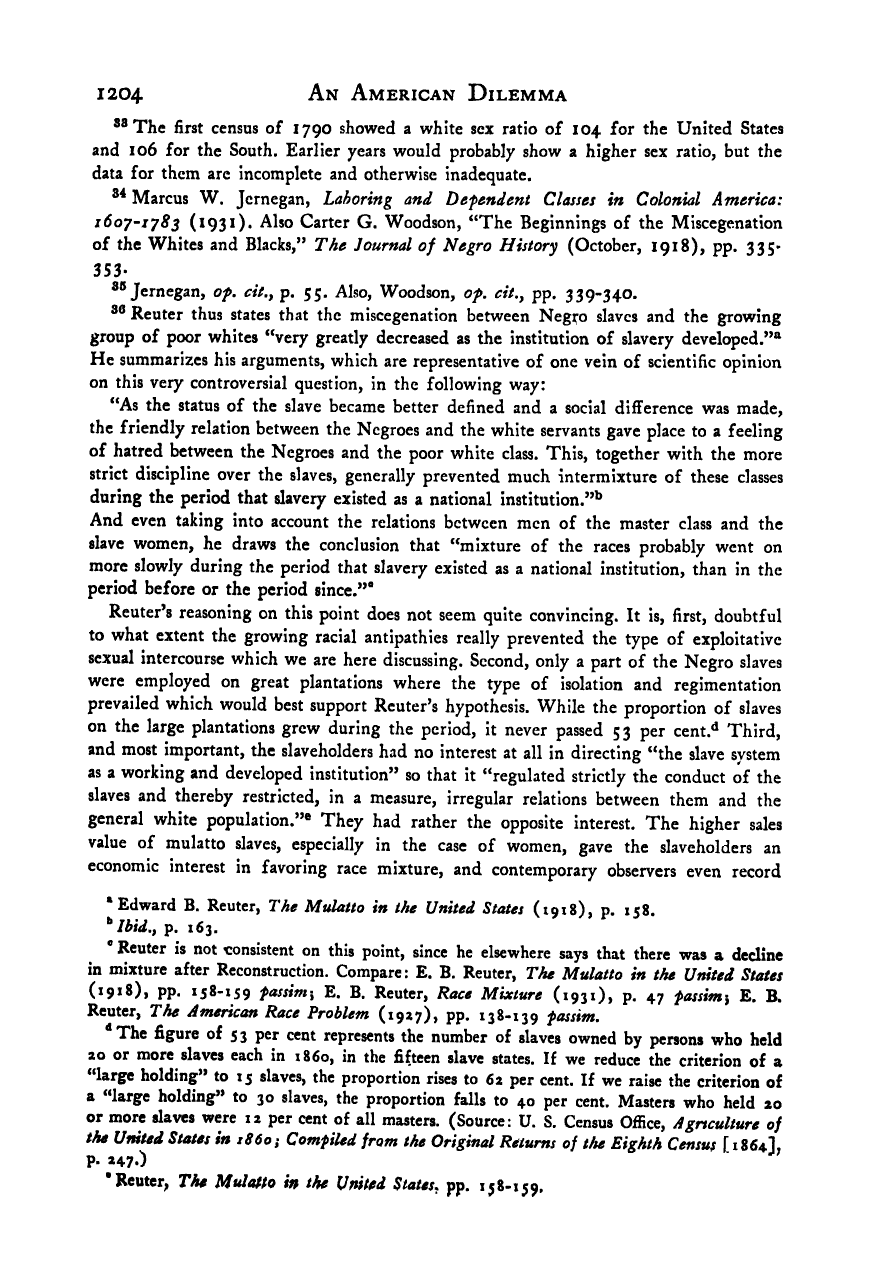Note: Gunnar Myrdal died in 1987, less than 70 years ago. Therefore, this work is protected by copyright, restricting your legal rights to reproduce it. However, you are welcome to view it on screen, as you do now. Read more about copyright.
Full resolution (TIFF) - On this page / på denna sida - Footnotes - Chapter 5

<< prev. page << föreg. sida << >> nästa sida >> next page >>
Below is the raw OCR text
from the above scanned image.
Do you see an error? Proofread the page now!
Här nedan syns maskintolkade texten från faksimilbilden ovan.
Ser du något fel? Korrekturläs sidan nu!
This page has never been proofread. / Denna sida har aldrig korrekturlästs.
1204 An American Dilemma
The first census of 1790 showed a white sex ratio of 104 for the United States
and 106 for the South. Earlier years would probably show a higher sex ratio, but the
data for them are incomplete and otherwise inadequate.
Marcus W. jernegan, Laboring and Defendent Classes in Colonial America:
i6oy-iy8s (1931). Also Carter G. Woodson, “The Beginnings of the Miscegenation
of the Whites and Blacks,” The Journal of Negro History (October, 1918), pp. 335-
353 *
Jernegan, of. cit.y p. 55. Also, Woodson, of. cit.^ pp. 339-340.
Reuter thus states that the miscegenation between Negto slaves and the growing
group of poor whites “very greatly decreased as the institution of slavery developed.”*^
He summarizes his arguments, which are representative of one vein of scientific opinion
on this very controversial question, in the following way:
“As the status of the slave became better defined and a social difference was made,
the friendly relation between the Negroes and the white servants gave place to a feeling
of hatred between the Negroes and the poor white class. This, together with the more
strict discipline over the slaves, generally prevented much intermixture of these classes
during the period that slavery existed as a national institution.”^
And even taking into account the relations between men of the master class and the
slave women, he draws the conclusion that “mixture of the races probably went on
more slowly during the period that slavery existed as a national institution, than in the
period before or the period since.”®
Reuter’s reasoning on this point does not seem quite convincing. It is, first, doubtful
to what extent the growing racial antipathies really prevented the type of exploitative
sexual intercourse which we are here discussing. Second, only a part of the Negro slaves
were employed on great plantations where the type of isolation and regimentation
prevailed which would best support Reuter’s hypothesis. While the proportion of slaves
on the large plantations grew during the period, it never passed 53 per cent.*^ Third,
and most important, the slaveholders had no interest at all in directing “the slave system
as a working and developed institution” so that it “regulated strictly the conduct of the
slaves and thereby restricted, in a measure, irregular relations between them and the
general white population.”® They had rather the opposite interest. The higher sales
value of mulatto slaves, especially in the case of women, gave the slaveholders an
economic interest in favoring race mixture, and contemporary observers even record
•Edward B. Reuter, The Mulatto in the United States (1918), p. 158.
^ Ibid., p. 163.
Reuter is not tronsistent on this point, since he elsewhere says that there was a decline
in mixture after Reconstruction. Compare: E. B. Reuter, The Mulatto in the United States
(1918), pp. 158-159 fassini\ E. B. Reuter, Race Mixture (1931), p. 47 fassim\ E. B.
Reuter, The American Race Problem (1927), pp. 138-139 fassim.
The figure of 53 per cent represents the number of slaves owned by persons who held
20 or more slaves each in i860, in the fifteen slave states. If we reduce the criterion of a
large holding * to 15 slaves, the proportion rises to 62 per cent. If we raise the criterion of
a “large holding” to 30 slaves, the proportion falls to 40 per cent. Masters who held 20
or more slaves were 1
2 per cent of all masters. (Source : U. S. Census Office, Agriculture of
the United States in i860; Comfiled from the Original Returns of the Eighth Census [1864].
P. 247.)
•Reuter; The Mulatto in the United States, pp. 158-159.
<< prev. page << föreg. sida << >> nästa sida >> next page >>